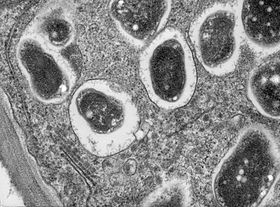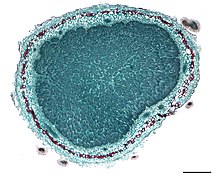Root nodule

Root nodules are found on the
.Within legume root nodules, nitrogen gas (N2) from the atmosphere is converted into
Symbiosis

Leguminous family
Plants that contribute to N2 fixation include the
Non-leguminous
Although by far the majority of plants able to form nitrogen-fixing root nodules are in the legume family Fabaceae, there are a few exceptions:
- bayberry can form (less complex) nitrogen-fixing nodules, thanks to a symbiotic association with Frankia bacteria. These plants belong to 25 genera distributed among 8 plant families.[6] According to a count in 1998, it includes about 200 species and accounts for roughly the same amount of nitrogen fixation as rhizobial symbioses. An important structural difference is that in these symbioses the bacteria are never released from the infection thread.[7]
- Parasponia, a tropical genus in the Cannabaceae is also able to interact with rhizobia and form nitrogen-fixing nodules. As related plants are actinorhizal, it is believed that the plant "switched partner" in its evolution.[8]
The ability to fix nitrogen is far from universally present in these families. For instance, of 122 genera in the
| Family: Genera
Alnus (alders)
|
...... |
Coriariaceae: Coriaria
Datiscaceae: Datisca
|
...... |
...... |
...... |
|
Classification

Two main types of nodule have been described in legumes: determinate and indeterminate.[9]
Determinate nodules are found on certain tribes of tropical legume such as those of the genera Glycine (soybean), Phaseolus (common bean), and Vigna. and on some temperate legumes such as Lotus. These determinate nodules lose meristematic activity shortly after initiation, thus growth is due to cell expansion resulting in mature nodules which are spherical in shape. Another type of determinate nodule is found in a wide range of herbs, shrubs and trees, such as Arachis (peanut). These are always associated with the axils of lateral or adventitious roots and are formed following infection via cracks where these roots emerge and not using root hairs. Their internal structure is quite different from those of the soybean type of nodule.[10]
Indeterminate nodules are found in the majority of legumes from all three sub-families, whether in temperate regions or in the tropics. They can be seen in

- Zone I—the active meristem. This is where new nodule tissue is formed which will later differentiate into the other zones of the nodule.
- Zone II—the infection zone. This zone is permeated with infection threads full of bacteria. The plant cells are larger than in the previous zone and cell division is halted.
- Interzone II–III—Here the bacteria have entered the plant cells, which contain amyloplasts. They elongate and begin terminally differentiating into symbiotic, nitrogen-fixing bacteroids.
- Zone III—the nitrogen fixation zone. Each cell in this zone contains a large, central vacuole and the cytoplasm is filled with fully differentiated bacteroids which are actively fixing nitrogen. The plant provides these cells with leghemoglobin, resulting in a distinct pink color.
- Zone IV—the senescent zone. Here plant cells and their bacteroid contents are being degraded. The breakdown of the heme component of leghemoglobin results in a visible greening at the base of the nodule.
This is the most widely studied type of nodule, but the details are quite different in nodules of peanut and relatives and some other important crops such as lupins where the nodule is formed following direct infection of rhizobia through the epidermis and where infection threads are never formed. Nodules grow around the root, forming a collar-like structure. In these nodules and in the peanut type the central infected tissue is uniform, lacking the uninfected ells seen in nodules of soybean and many indeterminate types such as peas and clovers.
Actinorhizal-type nodules are markedly different structures found in non-legumes. In this type, cells derived from the root cortex form the infected tissue, and the prenodule becomes part of the mature nodule. Despite this seemingly major difference, it is possible to produce such nodules in legumes by a single
Nodulation


Legumes release organic compounds as secondary metabolites called flavonoids from their roots, which attract the rhizobia to them and which also activate nod genes in the bacteria to produce nod factors and initiate nodule formation.[15][16] These nod factors initiate root hair curling. The curling begins with the very tip of the root hair curling around the Rhizobium. Within the root tip, a small tube called the infection thread forms, which provides a pathway for the Rhizobium to travel into the root epidermal cells as the root hair continues to curl.[17]
Partial curling can even be achieved by nod factor alone.[16] This was demonstrated by the isolation of nod factors and their application to parts of the root hair. The root hairs curled in the direction of the application, demonstrating the action of a root hair attempting to curl around a bacterium. Even application on lateral roots caused curling. This demonstrated that it is the nod factor itself, not the bacterium that causes the stimulation of the curling.[16]
When the nod factor is sensed by the root, a number of biochemical and morphological changes happen: cell division is triggered in the root to create the nodule, and the root hair growth is redirected to curl around the bacteria multiple times until it fully encapsulates one or more bacteria. The bacteria encapsulated divide multiple times, forming a microcolony. From this microcolony, the bacteria enter the developing nodule through the infection thread, which grows through the root hair into the basal part of the epidermis cell, and onwards into the root cortex; they are then surrounded by a plant-derived symbiosome membrane and differentiate into bacteroids that fix nitrogen.[18]
Effective nodulation takes place approximately four weeks after crop planting, with the size, and shape of the nodules dependent on the crop. Crops such as soybeans, or peanuts will have larger nodules than forage legumes such as red clover, or alfalfa, since their nitrogen needs are higher. The number of nodules, and their internal color, will indicate the status of nitrogen fixation in the plant.[19]
Nodulation is controlled by a variety of processes, both external (heat, acidic soils, drought, nitrate) and internal (autoregulation of nodulation, ethylene). Autoregulation of nodulation[20] controls nodule numbers per plant through a systemic process involving the leaf. Leaf tissue senses the early nodulation events in the root through an unknown chemical signal, then restricts further nodule development in newly developing root tissue. The Leucine rich repeat (LRR) receptor kinases (NARK in soybean (Glycine max); HAR1 in Lotus japonicus, SUNN in Medicago truncatula) are essential for autoregulation of nodulation (AON). Mutation leading to loss of function in these AON receptor kinases leads to supernodulation or hypernodulation. Often root growth abnormalities accompany the loss of AON receptor kinase activity, suggesting that nodule growth and root development are functionally linked. Investigations into the mechanisms of nodule formation showed that the ENOD40 gene, coding for a 12–13 amino acid protein [41], is up-regulated during nodule formation [3].
Connection to root structure
Root nodules apparently have evolved three times within the Fabaceae but are rare outside that family. The propensity of these plants to develop root nodules seems to relate to their root structure. In particular, a tendency to develop lateral roots in response to abscisic acid may enable the later evolution of root nodules.[21]
Nodule-like structures
Some
Gallery
-
Nodules on the Vicia Faba roots.
-
Soybean roots.
-
Robinia pseudoacacia nodules
-
Close up of dissected Medicago Root nodule of the Fabaceae plants family.
-
Fabaceae family root nodules.
-
Medicago italica nodules.
-
Cross section of the nodule.
-
Vigna unguiculataspp.) roots.
See also
- Root gall nematode
- Rhizobium
- Sinorhizobium
- Bradyrhizobium
- Neorhizobium
- Pararhizobium
- Common Symbiotic Signaling Pathway
References
- ^ Wagner, Stephen C. (2011). "Biological Nitrogen Fixation". Nature Education Knowledge. 3 (10): 15.
- PMID 28607058.
- PMID 12644643.
- ISBN 9780521648530.
- ISBN 9780716750796.
- S2CID 85913801.
- .
- S2CID 20501765.
- S2CID 22216527.
- ^ ISBN 9781444316384.
- S2CID 11658948.
- PMID 16384905.
- PMID 16648219.
- PMID 32276984.
- PMC 1488913.
- ^ PMID 12913154.
- )
- PMID 16547129. Online.
- ^ Adjei, M. B. "Nitrogen Fixation and Inoculation of Forage Legumes" (PDF). University of Florida. Archived from the original (PDF) on December 2, 2016. Retrieved December 1, 2016.
- PMID 21856632.
- PMID 21646084.
- PMID 17468111.










